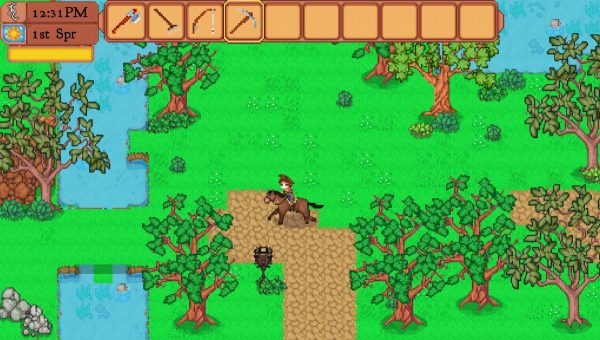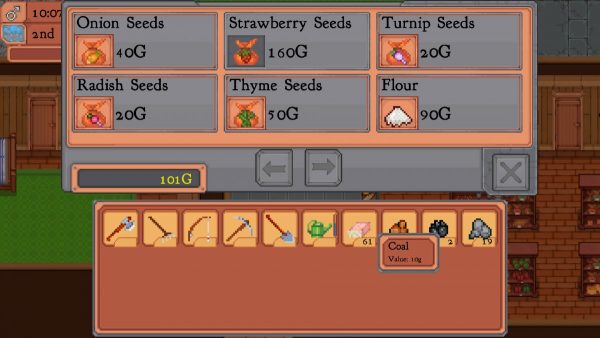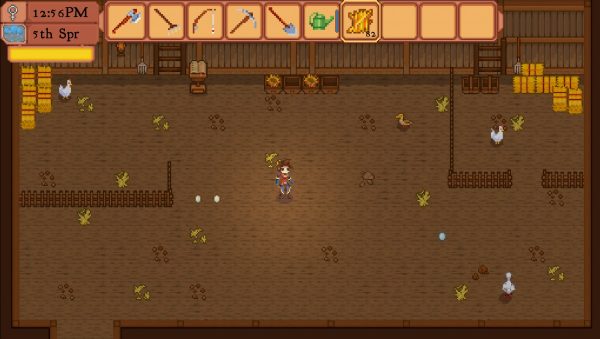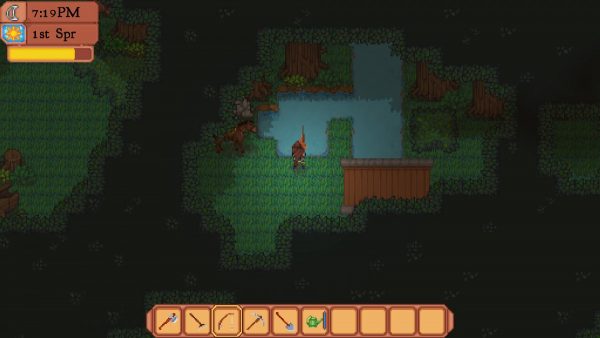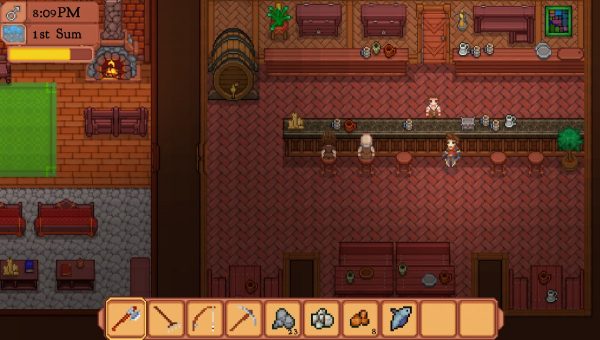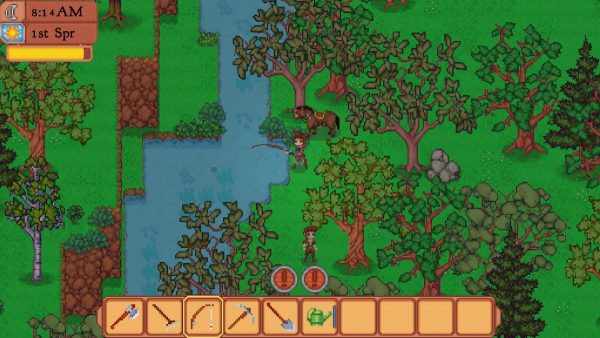Red Stewart reviews Verdant Village for PC (Steam)…
Sometimes great ideas emerge from the polymorphization of smaller ones. Take two radically different franchises, such as Final Fantasy and Disney, and throw them into a mixer- now you have Kingdom Hearts.
Likewise, new genres emerge from the combination of preexisting templates. One of the more interesting ones of the 2000s has been what I call the “farm RPG” spin-off, which has blended farm sims with role-playing elements to create games that emphasize resource gathering, exploration, social interactions, and energy conservation. Rune Factory, Terraria, and of course Stardew Valley are some of the more famous examples to emerge.
Developed and published by Exodus Software, Verdant Village is another such farm RPG (and perhaps the latest one, at the time of this article’s publication, to spring-up in the indie market). Unlike it’s predecessors, though, it seeks to differentiate itself through downplaying its agricultural roots and emphasizing the RPG aspects. The question is, was this wise and/or is it worth checking out? The short answer is too many issues exist at this time, but its spirit is strong. For the longer take read-on.
To clarify, Verdant Village is still in early access, meaning existing in-game content is prone to change. Indeed, during my own playthrough, I found many areas and buildings that were inaccessible, instead prompting the tagline “this area of the game hasn’t been implemented yet.” Per Exodus’s own words, they expect a fully-furnished product to be ready “by the end of 2020,” though are keeping potential delays open to “no later than Summer of 2021.” That being said, this review will attempt to be as fair as possible to the current state of the game, and a redux review may be issued at a later date closer to the Summer 2021 deadline.
We’ll begin with the story, which, at first glance, seems like the archetypal one seen in the Harvest Moon series wherein you play as a protagonist who is trying to make a living and name for themselves in a new town. The difference is, whereas in those entries you were presented as the inheritor of some piece of land, here the aforementioned role-playing principles come into play- your character has awoken on on a mysterious island with amnesia. After picking their gender, you’re rescued by the ruler of the nearby Kingdom of Amberglen and his daughter, who nurse you back to health, give you a house and plot, and leave you to your devices.
Obviously, functionally speaking, it’s the same as the beneficiary set-up , but there are subtle narrative differences implemented here that I was sad weren’t continued into the main game. For example, the daughter, Lorelei, openly questions why her father would leave you alone with a home instead of setting you up in the city inn. There was a missed opportunity to use this opening as a jumping off point to satirize (or, if you wanted to take it seriously, deconstruct) the tropes of the farm RPG genre, but alas, that is the extent you’ll see of this potential. From here on out, Verdant Village plays like any other similar title in terms of your interactions with the townsfolk- everyone you meet is mostly jolly, privy to telling you information about the area, and is openly willing to task you with very important things they need done. And yes, I understand this latter point is a trademark of RPGs in general (strangers entrusting strangers with quests), but considering the emphasis placed on your outsider status in the exposition, I was hoping to see some hesitation on the part of at least a couple of people.
But yeah, as far as the story goes, that’s about it. References are occasionally made by the citizens to a past crisis known as the “The Collapse,” but it’s as vague as “The Event” from The Big O. If there is more that comes out of the memory plot, I did not witness it in my playthrough. Pretty bare bones, but that’s also atypical of these types of games.
Next, we move onto the graphics, which coast on old-school artistry. Seriously, you have two different types of art here: the close-ups and the general arrangement. The close-ups are clearly derived from visual novels, with NPCs looking like kawaii anime characters. The general design, on the other hand, refers to what you see when you’re moving throughout the world, and here it seems that Exodus was influenced by SNES Quintet games. Maybe it’s solely cause of how hair was drawn, but I was reminded of classics like Illusion of Gaia, Terranigma, and Soul Blazer.
Now, to clarify, Verdant Village isn’t a carbon copy of those works- there’s something distinct about the way humans, nature, and architecture look. Humans are thinner, with rectangular faces compared to their oval JRPG counterparts. Trees vary depending on their genus, ranging from gnarled branches to grand-standing oaks. And buildings feel individually assembled, as though each homeowner had an active role in constructing their own dwelling- the residence of the blacksmith is smaller and more compact compared to the residence of the farmers, who have a sprawling mansion.
My point in listing all of these is that there is a true craftsmanship in Verdant Village that I have not seen in many famous older releases by such bigwigs as Square and Game Freak (take a look at any forest in any first-to-third gen Pokémon game for instance, or the inner layout of most abodes in Secret of Mana). It’s a testament to the artisanry of Exodus Software, and their commitment to making a unique environment to explore. None of this is even taking into account the changes caused by the four seasons, which are far from reskins and put Oracle of Seasons to shame in terms of aesthetic creativity. Summer nights bring you a flurry of fireflies, while springtime bathes the area in a yellow glare.
Speaking of glares, luminescence is creatively conveyed during dusk and twilight through the combination of a murky gradient, preexisting torches, and scotopic eyesight. By the former, I mean how the screen naturally darkens as the day goes by; by the middle, there are lanterns strewn throughout the landscape that automatically turn on during sundown, disclosing an annular glow that lighten up the pixels in their confines, and by the latter, I am referring to a radiance that surrounds your character- it’s labeled “night vision” in game, and you can earn perks to increase its ambit, but I was admittedly unsure as to how to receive said perks. Nonetheless, it blends quite well with the beacons during eventide.
Another thing I appreciated was how raindrops actually impacted the surface. In most smaller budget games, rain is presented as a pre-rendered particle effect that MIGHT cause nature’s tears to blur your perception, but is otherwise just a nonexistent backdrop that phases through things. In Verdant Village, it won’t impact your navigation, but you will see the droplets splatter upon contacting the ground, with two different versions in place depending on whether the beads hit a solid or liquid area. A rainy day also eliminates the need to water your crops, making it more than just a pretty overlay.
Not everything about the graphics is good, though. There were shortcuts taken, most notably with the shadows- they are nothing more than dark circles surrounding each person and component in the game. In fact, many things, like birds and the aforestated downpour, don’t even have that, making it a little disappointing.
On top of this, Verdant Village has an issue with its depiction of 3D spacing. What I mean by this is, 2D games obviously rest on creating the illusion of an extra dimension, and they typically do this through geometric prisms and land placement: how things are arranged and drawn on a flat plane can make wonders, especially when you throw in color.
The problem here is very hard to describe, but essentially nothing looks as elevated as it should be. Going through a complanate location such as a swamp or beach or ranch looks fine, however the second you arrive in a place with altitude, like grasslands with hills or a mountain pass, it can’t help but feel like you’re zigzagging your way horizontally rather than travelling vertically. I’m not sure why this is compared to other sprite-like games, but if I had to pick a theory, it would be the use of hues. The higher something is, the larger its shadow, and the larger its shadow, the darker its circumference of influence will be. In Verdant Village, every place has the same level of lighting, (and by lighting I of course mean the tint of an object since there aren’t real lighting systems). Because of this, there’s no sense of up/down distance or depth of field. I doubt it’ll ruin anyone’s experience, but it’s worth saying.
What WILL probably ruin people’s experiences, though, are the strange geography schemes that impact navigation. Verdant Village is one of the few times I’ve witnessed ordonnance in a video game that was pointlessly obstructive. Amberglen features structures and rivers like any other medieval-inspired hamlet, but it’s a genuine pain to walk through. Bridges are infrequently placed, architectonics bizarrely rise on acclivities, both of which impede your movement and force you to maneuver in weird angular shifts. You will find the placing of such static obstacles even worse in places like the morasses, jungles, and sierra bluffs even worse.
And it all made me wonder why? Why do this to players? Why have them waste a few extra (in-game) minutes having to oddly steer when you could have just designed the environments to be easy to roam? To give a great example of how this impacts motion, we can look at a small-scale version of this issue: to get from your orchard to Amberglen, you have to walk down, then right- why not just have you walk right? Why throw in that offbeat downward ambulation? It ruins the kinetic flow.
From there, we move onto sound, which is objectively unsatisfying. No voice acting exists, so I’ll begin with the SFX, which is a series of repetitious noises. Each action you can do has a set sound that does not alter no matter what- upgrade your pickax to a mithril one? Doesn’t change the fact that it hits ore with the same din as your original mattock. Want to pick up a piece of wood or a flower on the ground? Don’t worry, they “pluck” the exact same. What about cutting down a giant evergreen versus a slim palm tree? Well, if they both fell down in a Verdant Village forest where there was no one around to hear them and they made a sound, I guarantee you they would crash in a similar fashion.
There’s also the lackluster attempt at ambience. You get a lot of stock noises like frogs and mosquitoes in the marsh or wind in a field of grass or crashing waves by the waterfront, which wouldn’t necessarily be bad except that there is clearly no source for these audible pieces. There are no critters basking in the middle of a bog or shrubs swaying as though they are being blown or regenerating sea surfs. It really feels like it was thrown in last minute.
That being said, there is a saving grace with the music. The score, presumably composed by an in-house musician at Exodus, is very enlivening. It takes those symphonic melodies we’ve come to associate with the fantasy genre and modulates them for a smaller setting. There are only five or so tracks, and they play regardless of location or time of day, but I honestly preferred this over syncing attempts in past farm RPGs wherein you have a single theme for a designated locale that restarts whenever you reenter said area.
Now, having a different set of tracks for night/afternoon/day or adding individual OSTs for each season would be nice and a big improvement, but what you have here is very pleasant to hear. Regardless of the activity I was doing, I never found myself distracted by the compositions, which speaks to their universal tone.
Finally, we come to gameplay, of which there is a lot to talk about. As mentioned in the story section, the goal is to become a self-made man, but unlike preceding farm RPGs where you were encouraged to achieve this through recreating the Hanging Gardens of Babylon via your very own grand acreage, Verdant Village provides numerous ways to increase your personal wealth and income. Mining, hunting, fishing, foraging, archaeology, cooking, and even alchemy (amongst others!) are all valid avenues. The thing I enjoyed the most is how none are prioritized over the other- they all come with their own pros and cons that you will have to take into consideration when deciding which to pursue: mining can quickly get you valuable gems, but trekking to the quarry takes time and constantly breaking rocks tires you out quicker; you can go the old-fashioned route and cultivate a giant plantation, but keeping it moisturized daily and having to wait up to a week for the crops to grow is a time sink; fishing is simple and easy, yet you can’t guarantee whether you’ll get a prized trout or a common aquatic species, making it a bit of a gamble.
You can see that a commonality for all these activities is stamina, which is utilized for every action you do save walking and smelting. You can restore it through eating food and sleeping, but chances are you’ll exert yourself every day because of the relatively low endurance meter. Due to their not being a personal leveling-up system, I don’t know if you are able to increase your avatar’s capacity, but what I do know is that enhancing your tools results in their associated strokes draining you less and less as you improve them further. Many of these abilities do have their own associated experience bars that you can level up through repeatedly doing them, but I wasn’t sure what they yielded in terms of gameplay. Still, it can only be a positive thing.
In spite of the variety, Verdant Village suffers from a big grind issue, and I mean this economically (since there are no extravagant skill sets). With the exception of foraging, you will find it in your best interest to get better tools and/or order additional appliances so that you aren’t constantly weary from whatever enterprises you choose to pursue. To do this, you will need to manufacture metallic bars that the craftsmen in question (most of the time being the ironsmith Sven) will utilize for the upgrade. The problem is prospecting the caves for the minerals needed can be a drag- you will frequently run out of strength, forcing you to return home, rest, and continue the excavation in the next period ad nauseam.
It’s not just mining that has this headache. Like I noted before, woodcutting, fishing, and other ventures have their own toll that you will have to pay for the sake of progression. And while you will notice a decline in exhaustion through the refurbishing of your tools, the sheer amount of times you need to repeat a task ensures that you are in this for the long haul.
Another thing that ensures the long haul are the quests, which are a massive misfire. Every single one I played was nothing more than a gigantic fetch quest- a character either needs a ridiculous assortment or a ridiculous amount of items and it’s your job to go get them. Sometimes you’ll get an idea of what they want from their preceding description, but there are just as many times where you won’t know and may end up filling your log with an entry that you know will take a while, which wouldn’t be a negative were it not for the fact that your journal only has 10 spaces- try and exceed it and either you or the person you’re speaking to will inform you that you have too much to do, which makes no sense from either a story or gameplay perspective.
While all fetch-related, they can be divided into two categories: random and grubwork. The former requires you to find an item or items whose presence is dictated by a RNG. For instance, collecting seashells entails you to go to the shore and find the right husks, only the possibility of you getting all the ones you need is slim to none, meaning you’re going to have to make monotonous trips again and again until Mother Earth grants you respite!
Grubwork, contrarily, puts the furtherance mostly in your hands. You’re going to have to toil until you earn enough raw materials to get the NPC what they want. Sometimes this can be as simple as preparing an individual’s favorite meal, but other times it can be a massive investment. For example, if you want to increase the size of your rucksack, you’re going to have to get this chick 10 spools of wool. Sounds simple right? Well, to get wool you need sheep -> to get sheep, you need a barn -> to get a barn, you need 35 slabs of bronze -> to get bronze you need 105 pieces of copper, 70 tin, and 35 coal -> to get that you need to mine for a long while (and this isn’t even taking into account the assets you need to procure a loom to spin the fleece).
As you can imagine, both of these are tedious tasks, with the latter making the grinding worse than it normally would be. There could have at least been a silver lining in the form of juicy subplots wherein a narrative is conveyed through your dialogues with these characters; since the head shots already look they’re out of a VN, Exodus could have taken a further cue from that genre and really driven home interesting or humorous tales, but alas, these threads are as basic as a “a nearby village suffered a harsh winter, go get me 100 flax,” or “I want to make mushroom soup, go get me some fungi” or, my personal favorite, “get me these odd items cause I like them.” It also doesn’t help that the bulk of the NPCs are cut from the same types of cloth: you have the extroverted young females, the older blasé men, and the younger optimistic gents.
The worst part are the rewards. You would think, given the many past years’ worth of great sidequests in other franchises, that the developer would have understood the relationship between time sunk and award given, but they don’t. Ninety percent of the time, you’re provided with either recipes for your cookbook or useless furniture designs (not even the furniture itself, just the blueprint to spend money ordering it from a catalog).
That’s not to say that they’re all like this as there are a few tasks which unlock the previously mentioned skills (or the equipment needed for them), but the vast majority of them are. You will kill many in-game (and real life!) hours collecting scraps in exchange for instructions on how to bake a blueberry pie. It’s unfortunate when RuneScape, all the way back in the early-2000s, knew how to appropriately compensate players for their undertakings.
An additional flaw RuneScape unintentionally reveals about Verdant Village is its lack of a good market system, which could have not only added depth to the game but alleviated some of the problems with the quests. What I mean by that is, instead of having to waste your own time accumulating goods, you’re instead given the option to obtain them via trade or bargaining. To be fair, some of that exists through the storekeepers in Amberglen (you’re able to purchase sugar directly instead of growing sugarcane), but it’s nonexistent for ores, produce, flora, and animal skins. And though you are able to sell anything to any retailer, if you accidentally oversell an item to a shop, you’re unable to buy it back or undo the transaction. Seriously, imagine if a version of the marketplace system from Secret of Evermore was implemented here.
For all my complaints though, I will say that Verdant Village runs very well. Screen transitions are solid, there’s never any lag, and I only encountered two bugs in my playthrough, one of which was near-immediately resolved after contacting the developer on the Steam forums, which brings up a solid point: Verdant Village has a great community. Seriously, for a small indie title, it not only has extensive discussions going on in the comments, but also a burgeoning wiki that I was able to consult whenever I needed extra information on item locations and help with quests.
I believe part of the reason for this amassing of gamers is the relaxing atmosphere of the title. As you all are more than aware, 2020 has been a depressing year, and with September being the month for Suicide Awareness, that factor has only been amplified. A beautiful farming simulator that doesn’t pressure you or rush you or punish you, that has likable characters and a large open environment, a title that embraces freedom and serenity; THAT is the perfect remedy to indulge in for the remainder of the decade.
And the truth is all my big criticisms are amendable through patches and updates (which Exodus is, as we speak, constantly doing). Throw in the ability for your protagonist to build platforms or ladders and you solve the wayfinding issues; simply append supplementary dialogue to existing conversations with villagers to give their jobs more weight, and administer the option to mail order every supply so that players can prioritize and grind for what they want to do (hide it behind a quest if you don’t want to put it upfront!).
As noted, Verdant Village is currently in early access, but you can still play it for the price of $15.00. RPGs, of course, technically provide enough content, but you have to understand that a good chunk of it comes from iterant undertakings, and the pitfalls I outlined above, while fixable, aren’t yet fixed.
If you’re a fan of this genre, want a calming game to wallow in, and wish to support a passionate independent developer who is actively working every week to make their game better and better, then Verdant Village is for you.
Pros:
+ Unique art style
+ Peaceful setting
+ Diverse endeavors
+ OST
Cons:
– Navigation
– Poor SFX
– Nothing but fetch quests
– Grind heavy
Rating – 6/10
Red Stewart


